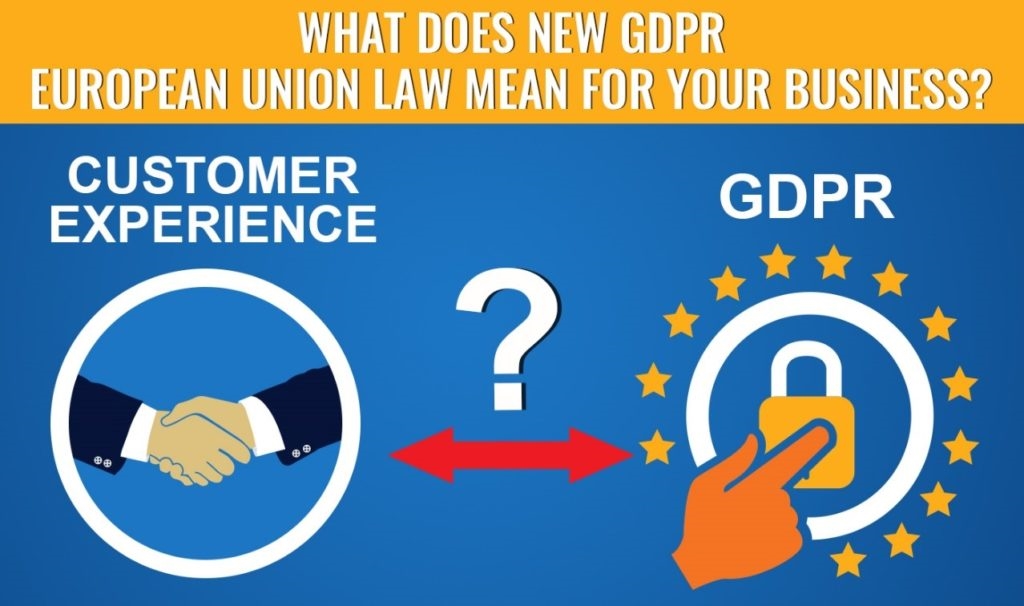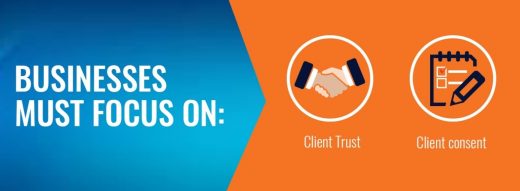What does GDPR European Union law mean for your business?
What does GDPR European Union law mean for your business?

Today’s consumers are more powerful than ever before, and get every bit of information that they can before they make a purchase. The Internet is helping them greatly, and most of the buying is done online. The pace is so rapid that it won’t be long before online purchases are more common than offline ones.
What does this mean for businesses?
You have to unify your marketing and sales channels so that you can understand your consumers better, and can offer them a personalized cross-channel experience. Customer experience is the trick to mastering this. And so, you must come up with ways that allow you to improve and offer a seamless customer experience across all channels, so much so that you outdo your competitors if you want most of the market share.
Consider the examples of Apple, Amazon, and other giant retailers out there. What are the common elements in their marketing and sales campaign? Following potential leads and consumers over multiple channels and sending them personalized messages. They have advanced analytics systems in place that give them insight, which are then used for delivering a better customer experience than before.
As of now, current technologies allow businesses to control their clients’ data. But all this is going to change next year when new laws are enforced in the European Union, .referred to as the General Data Protection Regulation (GDPR). A law that gives consumers control over their own data and companies must become aware of these new policies, understand the manner in which they will be affected, and take necessary steps to achieve compliance.
Understanding the New Law
The GDPR law shifts data control in favor of clients, and using that control, they will be able to decide which companies can store and use their personal data. They’ll be able to specify the exact manner in which their data could be used by businesses.

The GDPR Standards
As a part of becoming compliant, businesses have to meet GDPR standards.
- Implement correct data management policies.
- Understand and know clients’ rights in light of the new law. Accordingly, you should be able to take appropriate action at the request of your client.
Clients’ Rights
The GDPR law gives the following rights to all clients.
- Submit a formal request to access their personal information, which a company has.
- Rectify their data and restrict the company from processing it.
- Ask a company to completely remove their data.
- Withdraw consent for any reason at any time.
- Obtain and reuse their data across different platforms for individual purposes.
Building Trust and Gaining Client Consent are Important

Organizations should manage their processes efficiently so that they can become compliant. They must understand and mitigate risks, while simultaneously building trust with clients and gaining their consent. This should be a key focus because without client consent, no business is allowed to take any kind of action with personal information for anything other than contractual or legal obligations. When they do get it, they will be able to collect, use, process, and store the data, but only how the clients want them to.
Consequences of Not Complying
What if businesses decide to ignore all this and not bother with compliance? Data Protection Authorities have several measures to enforce GDPR provisions, ranging from a reprimand to a ban on data processing altogether, and fines up to four percent of the global annual turnover.
And it doesn’t end here; you will lose client trust, and may well end up damaging your reputation. All of this will affect your other potential and new customers as well, and they may decide not to buy from you, meaning you will lose both leads and money. Data breaches for instance cause a permanent 1.8% drop in stock prices due to reputational damage (Oxford Economics and CGI).
What are the challenges involved?
It is absolutely essential to maintain client trust and stay compliant, and this is true irrespective of the industry you operate in. But let’st take a look at some of the challenges involved.
Challenge #1: Locating Information
You are compliant to GDPR when you can respond to clients, letting them know what information you have on them. But the problem is that most of you may not even be aware of where you store this data, which may prevent you from responding promptly if clients want their data to be removed. Consider the banking industry for instance, where they usually have files and files of data, dating back to over 10 years ago; the old records wouldn’t even be digital. Thus, you may find it difficult to quickly locate clients’ data.
Challenge #2: Managing Data Streams
Businesses usually have numerous data streams to handle, and when working towards compliance, managing these effectively will be a challenge. Also, since you would need clients’ consent, you may not be able to use any sensitive details in any of your application systems; it all depends on how the clients want you to handle their data.
What solutions can an organization implement?
Achieving GDPR compliance means that businesses should take several steps at their end. These can be defined as follows at the highest level.
- Locate and document the processing of personal data, and make it transparent to your consumers.
- Ensure that personal data can be accessed, transported, and deleted so that you can quickly respond to clients’ requests.
- Store all personal details in a manner which complies with GDPR.
- Gain protection from data breaches, and minimize the risks involved.
- Monitor and manage data continuously to ensure that GDPR standards are being met.
Protecting Client’s Data
Protecting clients’ data is crucial if you want to gain their trust. Protection by Design is a recommended approach because it promotes privacy and compliance through the data lifecycle. The two most common techniques are pseudonymization and data minimization.
Pseudonymisation lowers risks by translating data into not-directly personal identifiable information. It remains personal data because you can still combine it with other pieces of data, such as a translation of the pseudonyms. But without this additional information, the data remains anonymous if it would fall into unwanted hands. Data minimization, on the other hand, is a technique that lowers risks by using only that what is strictly necessary to fulfill the intended purpose. This way datasets remain as small as possible, lowering the chance for unintended use or damage in case of a data breach. When privacy risks are minimized, your clients trust you more and are assured that their data will remain secure throughout the process.
Implementing the Technical Infrastructure
Your infrastructure should be compliant, controlled, and portable. Collect data only for specific purposes, and give your customers the right to object. The information which you do gather should be stored in a self-controlled environment and subjected to protection regulations. You can also implement a data governance solution to get deeper insight into the entire lifecycle. This will also help you in building a searchable catalogue of all information while developing an access and control point for data related tasks.
Minimizing the Risks
- Review your current processes, and create documentation on personal data your company handles and the methods through which you obtain it.
- Bring data protection officers or DPOs on board so that they can help you define personal data and achieve compliance.
- Use data stream manager applications to handle all your data streams. Doing so, you will be able to process these streams in real time, allowing you to respond to clients’ requests more quickly.
Want more useful information on GDPR? Follow Ronald van Loon and Janus de Visser to stay updated with the latest on GDPR, understand your role, and learn the tricks to gain compliance.
The post What does GDPR European Union law mean for your business? appeared first on ReadWrite.
(30)


